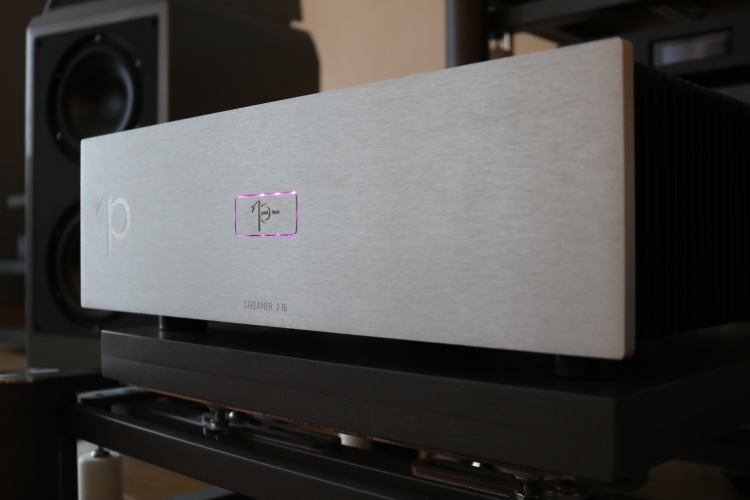
A super-precise and highly refined beast of a music server
Retail prices in the Netherlands:
2.16x server – 12.999 euro
SPDIF Bridge with standard 24.576 Mhz OCXO – 1019 euro
24.576 Mhz ultra-low noise OCXO – 1512 euro
PCX-ultra Power Cable – 3490 euro
“The 2.16x is a Cannon,” said Jord when he delivered the unit, and I can only concur. This thing is huge, heavy, and packed with custom power supplies, custom audio boards, and multiple clock boards, all connected using thick custom wiring. The Pink Faun 2.16x sure is an impressive piece of hardware and the pink/purple-ish LEDs that are placed all around the centrally-placed power button are a nice touch, which also makes the server instantly recognizable as a Pink Faun product. Its built-in versatility and the availability of various Pink Faun interface boards to customize it, allows one to tailor it precisely as needed. While I feel that its rather basic old-school amp-like appearance does not do justice to its hefty price tag it is nevertheless abundantly evident that this very solidly built beast means business.

Technically, this server is more advanced than any other server that I’ve used so far. As enthusiastic as he is, Jord overloaded me with technical info, of which must admit to only remember the highlights. Fortunately, Pink Faun have loads of information available as part of white sheets. Rather than relay all of that here, I’ve added all the technical information on this review’s last page and will mention only the highlights here.

The 2.16x includes a massive in-house designed linear power supply with three transformers and separate regulation for every part of the server. For example, the ATX connection to the motherboard contains 5 different voltage levels, all of which have their own linear regulation. Also, each SSD has its own linear regulation, the processor, every OCXO clock, and one can add more as needed. Then, there are lots of output options using dedicated interface boards such as SPDIF, I2S, and USB, all timed using super-accurate OCXO’s (Oven Controlled Crystal Oscillators). For the latter, Jord made it clear that at Pink Faun they do not seek the best long-term stability but the best short-term stability coupled with the lowest possible phase noise clock. The 24.576 MHz clock used for this review, for example, has a phase noise of -132dB measured at 10Hz which results in an RMS jitter of 81.117 femtoseconds.
Configuration
The 2.16x was delivered with a Pink Faun USB board and a Pink Faun SPDIF board pre-installed. Both boards were outfitted with OCXO clocks that are already of very high spec but as an extra, Jord had taken with him the new Pink Faun OCXO ultra-low noise clock which has such extreme specs that it cannot be ordered off the shelf. That’s why Pink Faun had it especially made for them, precisely to their spec. Also delivered was a Pink Faun I2S board which can also take advantage of the new OCXO ultra-low noise clock. After the initial comparisons of the standard OCXO Clock and ultra-low noise OCXO clock, which I will describe further down, I opted to stick with the OCXO ultra-low noise clock for the SPDIF board and the I2S board. Finally, also part of the delivery was the very thick and very heavy PCX-ultra power cable as well as a very nicely made custom I2S cable. The 2.16x was left switched on as much as throughout the review and unless noted otherwise, used with the PCX-ultra power cable.
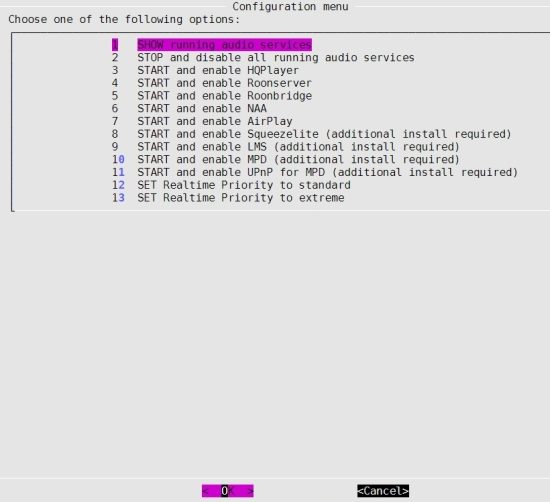
Above: AudioLinux main configuration menu which can be reached via a web browser.
Each output in Roon was set up using the Default buffer setting and only one was active at any time. Inside the PinkFaun AudioLinux Configuration Menu, only the required services were enabled and Realtime Priority was set to Extreme. The “extreme-ness” of the server can be taken one step further by using the more tweaky Ramroot method and/or Extreme 2 but I decided to refrain from trying this and used the server in its normal operational mode for this review. But before proceeding to my descriptions of the listening sessions, let’s get some more of the variables out of the way.
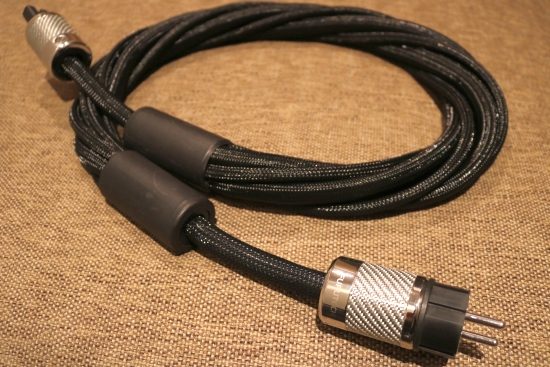
PCX ultra Power cable
The majority of the review of the 2.16x was done while using the PCX-ultra power cable but for the sake of equal comparisons, I also briefly connected the server using a Belden 19364 cable with Bals schuko and Oyaide C-004 connectors, the same as I use on all the other components. Believe it or not, whether it is the server itself or its output signals or the entire system responding to the presence/absence of the PCX ultra power cable, this makes a very noticeable difference for the sound. Naturally, Pink Faun will want to sell their own power cable with their server but it’s clear that it is not without reason because the PCX ultra makes the server sound considerably warmer and smoother as well as more organic in the midrange than when using the Belden. While warm-sounding cables can often harm the perceived speed and timing, also with music servers, the 2.16x sounds tight and fast-paced with either cable. Although the server sounds impressively open and transparent even with the relatively simple Belden cable, I much preferred its smoother and warmer presentation using the PCX-ultra power cable and so I used it for the duration of the review.
HQ Player Embedded
The 2.16x includes HQ Player Embedded but this offers such wealth in functionality that it would easily double the length of this review if I went into its possibilities in depth. So, for the purpose of this review, I will perform a couple of tests using RoonServer and either RoonReady or HQ Player as the renderer but I will not go into the various filtering- and upsampling methods. The Roon sound was assessed without upsampling or DSP and the HQ Player sound was assessed in PCM output mode. And sure enough, there are differences between the two. With HQ player enabled (for 30 mins at a time as part of the trial version), the sound was tighter and even more focused than via RoonReady. The latter, however, sounded more relaxed and subjectively more free-flowing and spacious. Purists might feel that HQ player provides the best sound and perhaps it gives the most accurate delivery indeed. However, I find the 2.16x itself to be inherently already more than focused and articulate enough and so I preferred the 2.16x using RoonReady and this is how I used the server for this review.
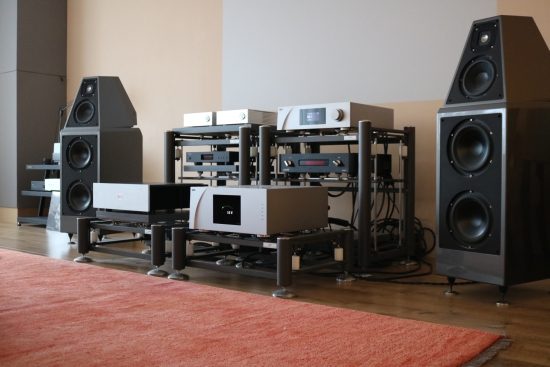
Initial Listening
There are plenty more options to get into but I will get to this further down. First, let me explain how the Pink Faun 2.16x sounds. I will try to put this into perspective using three other music servers: the AudioAanZee Reference Flow MKII, the Antipodes CX+EX, and the Melco N1ZH. The surrounding system consists of the CH Precision C1 DAC and A1.5 power amp, connected with a Cardas Clear XLR interlink. Speakers are the Wilson Watt/Puppy 8, connected with Jorma Design no.3 speaker cables. Alternatively, I will be using two Aqua DACs: the La Voce with USB and the Formula xHD DAC with USB as well as I2S, both together with the Ayon Stealth DAC and analog tube preamp, in this case, used only as a preamp. All power cables, except the one for the Pink Faun 2.16x which is used with its PCX-ultra power cable, are Belden 19364 with Bals schukos and Oyaide C-004 IECs.

All music servers that I tested have their own unique set of characteristics and indeed the 2.16x also has its own character. Although there are marked differences between USB, SPDIF, and I2S, irrespective of the output that is used, overall, I would characterize its sound as tight, fast, transparent, articulate and very precise and while these descriptors could also indicate a sound that is overly clinical, this is not the case with the Pink Faun. In addition to its precision and transparency, the server also has a pleasant warmth in the midrange and a very fluid and highly refined treble. Indeed, its resolution is first-rate but while the treble can become dry or “square-ish” with other very precise digital components, the opposite is the case with the Pink Faun which no doubt has a lot to do with its magnificent power supply and very precise clocking. Regardless of its operating mode or output method, this is a very articulate and precise yet subtle and highly refined server, even more so than the Antipodes combo. Moreover, while the 2.16x is very quiet and has a lot of black between the notes, the notes themselves do not simply start and stop staccato-style, rather, the subtle decays linger on seemingly forever.

Above: CAD (Computer Audio Design) USB 1 – the best match with the 2.16x in this system
Jord warned me not to use silver cables and while silver certainly does not always sound edgy or bright, indeed I found that the 2.16x should be used with neutral to warm-sounding cables. When used with a Belden power cable instead of the PCX-ultra power cable or the AudioQuest Diamond USB cable, for example, the server’s liveliness can turn into a tendency to sound thin in the bass and hard in the upper midrange. At this point, I should note that the Wilsons also have a similar tendency every now and then, so in a different system, the balance may work out differently but still, the relative differences between the 2.16x and other servers remain.
Resolution, refinement, tightness, and transparency may be the 2.16x’s most obvious characteristics but what I personally find even more impressive is the way that the server sounds using its SPDIF outputs.
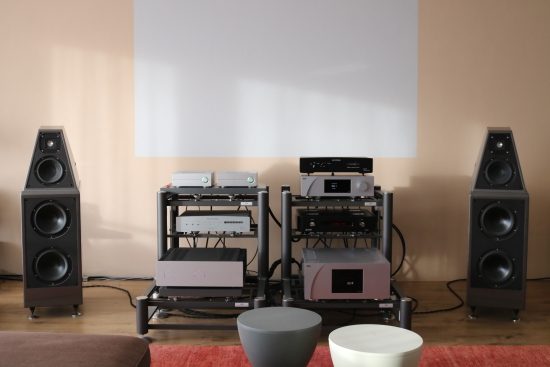
SPDIF / USB
In my experiments, SPDIF has always sounded more sonorous and smoother than USB while the latter has always countered with tighter bass and overall higher precision. With the Pink Faun, the offset between its USB- and SPDIF outputs is similar to what I heard before, but with a twist. Let’s begin with the differences between USB and SPDIF, using the standard OCXO clock on both boards. In this comparison, SPDIF sounds most voluptuous and full-bodied with the most convincingly real vocals in terms of seemingly possessing a 3D body as well as in timbre and texture. Here, too, the added organic qualities of SPDIF come at the expense of the overall transient speed which is most obvious in the bass, which is tighter and more articulate with USB. However, it’s not just the bass – everything is tighter via USB, which for some ears (cough-mine-cough) may translate into a more factual or less musical presentation. Personally, therefore, I mostly prefer the SPDIF board but depending on the music, sometimes I prefer the USB board. Electronic music, for example, sounds most impressive via USB. But good as the SPDIF output sounds at this point, there’s an upgrade that can be done to make it sounds even better.
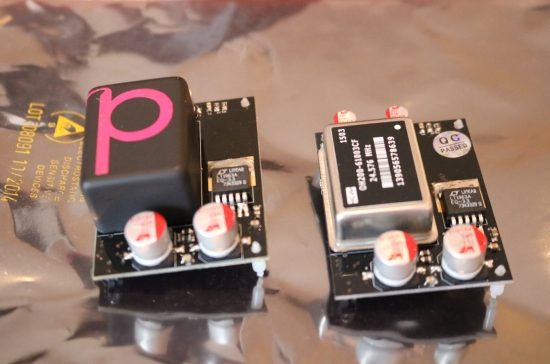
Left: new ultra-low noise OCXO clock, Right: “regular” OCXO clock.
Clocks
All the Pink Faun interface boards are already outfitted with very high-quality OCXO clocks but these can be further upgraded using the new OCXO ultra-low noise clock. The module is true plug-and-play and can be swapped with the server still switched on. As indicated, the SPDIF board already works wonders using the normal, already highly precise, clock and to be honest, I feared that an even more accurate clock might pull things in the wrong direction but after exchanging it for the OCXO ultra-low noise clock, a combination of things happens. First, you notice how everything seems to breathe more freely and decays are easier to hear. Second, you notice that the clarity has further increased but in the opposite of a clinical sense. Rather, the delivery comes across as more natural. Finally, the layers in the depth plane have become more clearly distinguished from each other, making everything seem more lucid but at the same time more organic. Going back to the normal clock, the aspect that stands out most is indeed that of a comparatively flattened soundstage. After that, what remains mostly is a sense that the sound has homogenized somewhat. The change may appear subtle at first but nevertheless is not difficult to hear. While still not as super-tight as USB, the OCXO ultra-low noise clock manages to pull the SPDIF output more in focus to make for an ideal balance between the virtues of USB and SPDIF. Although the OCXO ultra-low noise clock is a pricy option, given the bump in performance that it enables, I’d consider it a worthy upgrade. Indeed, such were the benefits that I chose to keep the OCXO SUPER clock in place for the subsequent listening sessions. Since we landed on this side trail anyway, let’s get some more variables out of the way and then I’ll get to the comparative listening part.

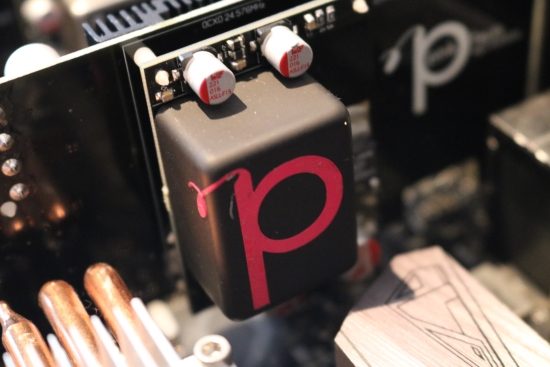




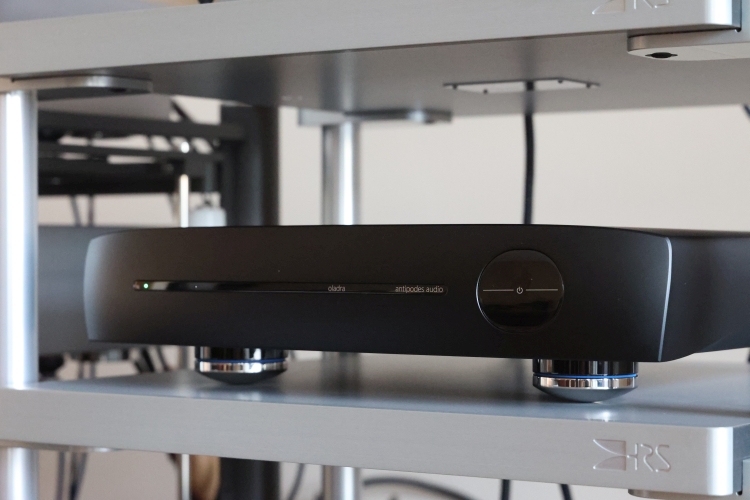
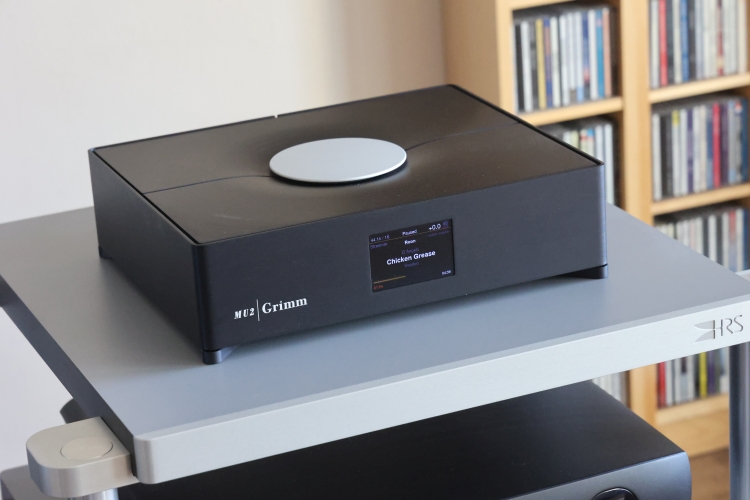
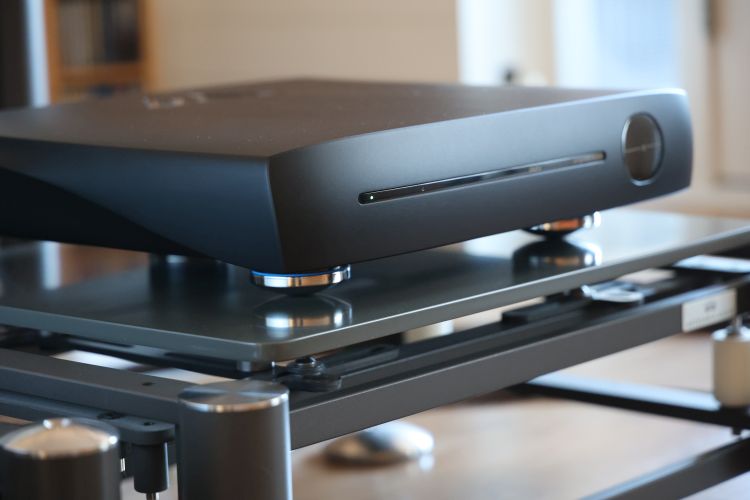
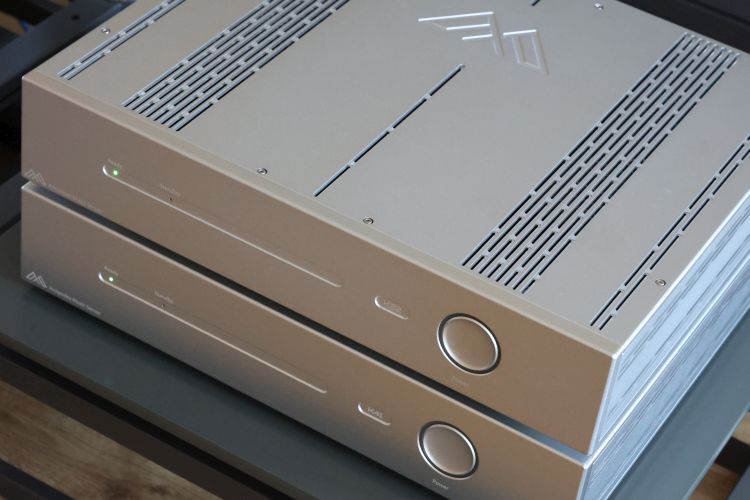
Christiaan, I am reading some interesting things about the 432 EVO MASTER server. It is said to be one of the best sounding servers on the market, would you be able to get one in for a review? I would like to know how it compares to the Pink Faun 2.16X
Hi Paul, actually, I was approached by Frederic vanden Poel during the XSFi show a few weeks ago about reviewing his latest server. So, that may well happen:-)
That would be great. I’d love to know how the Taiko Audio Extreme compares as well, especially to the 2.16x. I’m looking for a quality server, just wondering if I need to save a little more!
Haha yes, I understand. Although there are currently no plans for testing this server it’s still on the TO DO list.
Very impressive review.
I have a Aqua la scala mk2 dac and a SOtM sms200ultra using it as roon endpoint. I’m mainly interested in the upcoming PF Scion but this review was very useful, both because I guess the Scion will have a similar sound signature as the 2.16x and because of the comparisons of usb and i2s.
Thanks,
Rick
Hi Christiaan,
thia is another excellent review, highlighting all aspects of audiophile servers.
To further explore the top league of servers you should review the following:
Taiko Audio SGM Extreme
and
Innuos Zenith Statement
Thank you
Matthias
Hi Christiaan
Nice review. Are you planning in the near future to review the Grimm MU1?
Iam in the race to buy a new streamer for my Mola-Mola Tambaqui dac, the question is what to buy.
Martin
Hi Martin, I may well indeed but have no plans as of yet. However, I understand from a colleague reviewer whose opinion I trust that the MU1 with Tambaqui is one of the best server/DAC combo’s he’s heard.
Hi Christiaan, I am very keen to find out what your opinion is of the above. Shame that these boards are all additional upgrades that come with additional expense. I have upgraded to the HD board on my C1 at least so now twiddling my thumbs waiting for another splendid review lol ; )
Hi Paul, the review of the Roon Ethernet card has been out for a while. As outlined there in detail, with the Antipodes CX, I do indeed now prefer Ethernet over USB. For the easiest way to be notified of HFA updates, please check the HFA Facebook page where I post all articles that are coming up as well as when they have been published. PS: I agree that the cards are not inexpensive but at the quality level of the C1, I’m afraid that nothing is… in any event, all the CH updates so far have proven to be absolutely worth the expense.
Hi Christian, good review, I’ve been thinking of either getting a Pink Faun 2.16X or something from Taiko Audio who make the SGM gear, I’m very close to getting an Aqua XHD Dac but I also have a Tidal Preos D as well and wondered if it would be worthwhile getting the IS2 board for play through the Aqua XHD and then RCA Connection to the Preos and the Spdif board for going straight to the Preos, would be interested in your thoughts ?
Hi Shane, without exception, I2S has always sounded best to me. I’ve not heard the Tidal or the Taiko Audio/SGM and so can’t comment on this. I do think that the Pink Faun and the Taiko may well be the two best servers in the world. I would advise to listen to them both. If it helps, I always like having options because circumstances can and often will, change, so preparing both coaxial out and I2S is always handy. FYI Aqua has recently issued a V2 output board that adds some more “presence” and “dynamics” to the sound of the xHD, very worthwhile.
Hi Christian, yes I just ordered the Aqua on Wednesday so it’s coming straight from them and should be updated to the latest spec. Do you think getting the Ultra Clocks make a difference to just the normal clocks that can be fitted. For the added price I think it would be a no brainier not to get the Ultra Clocks to boost the performance.
Hi Shane, the ultra clock definitely made a very noticeable difference, making the sound more organic and refined and more natural, less measured, which is interesting as the precision should have actually gone up. That’s the wonderful world of high-end audio, I’m afraid:-)
Hello Christian,
I was wondering if you had heard the 432 EVO Master server and the APL DNP streamer. If so, how would you compare them to the Pink Faun 2.16x streamer ?
Hi Sylvain, Alas, I have not heard the latest 432 server nor the APL but having hear the original 432 EVO I know that it has a very different presentation than the Pink Faun. The former is most notable for its smooth, relaxed and organic 3D sound while the latter is all about transparency, articulation and transient speed. That’s not to say that the 432 lacks detail or the PF cannot sound organic but assuming that the 432 has not changed, basically, the decision is between more relaxed and more articulate.
Hi Christian, thanks a lot for this review and for sharing your inner debates!
As the first comment on this page, I am interested in the comparison with the PF and the CX/EX combo. Clearly the issue we all have is that it is impossible to compare them into our own system the way you did it.
I do have Wilson Audio’s speakers as well and two DACs with tube based outputs, one DAC connected over SPDIF or AES (I switch depending on the type of music – I share your observation) which deals with PCM only, and another one which has its own high quality streamer embedded so connected over ethernet. The latter is more recent, of course, but I could not completely abandon the organic sound of the former on voices. My pream and amp are solid state, very dynamic and great with transient, but still with very analog sounding on the Wilson Audios.
Three questions for you:
1) did you make any comparison using ethernet connections and consequently an external streamer (guess that the EX in this case is useless, so more the CX vs the PF connected over ethernet)?
2) it reads like you had to play a lot with the PF and the connections for getting an organic, non-excessively transparent and forward sound through the Wilson Audios. Should one be worried? For instance, I can’t stand to listen to them with the traditional dCS electronics, and with most of solid state pre-/amplifiers.
3) any thought on how PF compares with the InnuOS statement?
Thanks!
Hi Fabien,
Alas – I’ve not heard any of the Innuos servers.
When the PF was here I did not use it as a streaming endpoint and neither did I compare it to the EX or CX as a streaming endpoint. However, I did change to using the Antipodes CX as a server streaming directly to the C1 using its RoonReady Ethernet card. You can read about this and how it compares to USB in the CH Precision Ethernet_IN HD board Upgrade review.
With the Wilsons and using USB, I found the PF to be too clean for my taste and that’s why I preferred the arguably more organic Antipodes combo even if the PF operates on a higher audiophile level. When using the SPDIF board, however, the PF was really great. But its inherently very high precision means that the pairing with very expressive, at times slightly edgy and intrinsically “trigger-happy” speakers such as the Wilsons could result in an overly-controlled sound. In that case, some mellowing elsewhere in the system may be desirable and this could be done with the server choice (which also downgrades the resolution) or perhaps by using smooth cables.
With the Logans or Kromas, or other smoother sounding speakers, this may be entirely different.
I have a question on the ultra clock for the SPDIF bridge. What does it do in terms of warmth, density, thickness and “bloom”? Is the sound warmer as well (on top of being more natural and organic)?
It’s been a while but off the top of my head maybe the SPDIF bridge output is slightly warmer than USB (in the sense that it has more bloom) but then only very slightly. Mostly, it injects more flow and a more organic quality. I don’t feel that it clogs up or thickens the sound in any way.
great review! … and yet, hand on heart – in 2025 – what do you like more as a technology (in terms of sound quality) – CD transports or computer servers?
It depends on what one wants. I personally want the cleanest, purest, most uneditorialized sound, without it becoming clinical or devoid of life, emotion, and lyrical qualities. To achieve this with a music server is, perhaps unexpectedly, much harder than with a good CD transport. However, I much prefer the comfort of having a library at my finger tips, creating playlists, making quick and easy AB comparisons, etc. If you want stereotypical “analog” warmth, smoothness, and fluidity, well, servers can also do that very well these days. However, many such servers also reduce PRaT, transient attack, or the expression and liveliness in the process. Playback software also has a say in this.
To answer your question literally: as a technology, I prefer music servers and streaming. But I continue to be amazed that it is so much easier to obtain superb sound from a good CD transport, and so easy for a server or music playback software, to dilute the result.